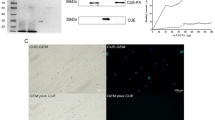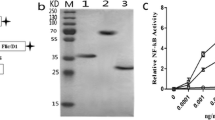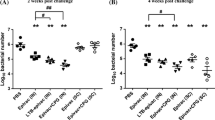Abstract
Epitope vaccine based on the enzyme urease of Helicobacter pylori is a promising option for prophylactic and therapeutic vaccination against H. pylori infection. In our previous study, the epitope vaccine CTB-UA, which was composed of the mucosal adjuvant cholera toxin B subunit (CTB) and an epitope (UreA183–203) from the H. pylori urease A subunit (UreA) was constructed. This particular vaccine was shown to have good immunogenicity and immunoreactivity and could induce specific neutralizing antibodies, which exhibited effectively inhibitory effects on the enzymatic activity of H. pylori urease. In this study, the prophylactic and therapeutic efficacy of the epitope vaccine CTB-UA was evaluated in a BALB/c mice model. The experimental results indicated that oral prophylactic or therapeutic immunization with CTB-UA significantly decreased H. pylori colonization compared with oral immunization with PBS. The results also revealed that the protection was correlated with antigen-specific IgG, IgA, and mucosal secretory IgA antibody responses. CTB-UA may be a promising vaccine candidate for the control of H. pylori infection.






Similar content being viewed by others
References
Abbas AK, Murphy KM, Sher A (1996) Functional diversity of helper T lymphocytes. Nature 383(6603):787–793
Blaser MJ (1990) Helicobacter pylori and the pathogenesis of gastroduodenal inflammation. J Infect Dis 161(4):626–633
Cameron EA, Bell GD (2005) Long-term follow-up of Helicobacter pylori eradication therapy in Vietnam: reinfection and clinical outcome. Aliment Pharmacol Ther 22(1):76–77
DeLyria ES, Redline RW, Blanchard TG (2009) Vaccination of mice against H. pylori induces a strong Th-17 response and immunity that is neutrophil dependent. Gastroenterology 136(1):247–256
Eaton KA, Brooks CL, Morgan DR, Krakowka S (1991) Essential role of urease in pathogenesis of gastritis induced by Helicobacter pylori in gnotobiotic piglets. Infect Immun 59(7):2470–2475
Ermak TH, Giannasca PJ, Nichols R, Myers GA, Nedrud J, Weltzin R, Lee CK, Kleanthous H, Monath TP (1998) Immunization of mice with urease vaccine affords protection against Helicobacter pylori infection in the absence of antibodies and is mediated by MHC class II-restricted responses. J Exp Med 188(12):2277–2288
Ferrero RL, Thiberge JM, Huerre M, Labigne A (1998) Immune responses of specific-pathogen-free mice to chronic Helicobacter pylori (strain SS1) infection. Infect Immun 66(4):1349–1355
Fujii R, Morihara F, Oku T, Hifumi E, Uda T (2004) Epitope mapping and features of the epitope for monoclonal antibodies inhibiting enzymatic activity of Helicobacter pylori urease. Biotechnol Bioeng 86(4):434–444
Gomez-Duarte OG, Lucas B, Yan ZX, Panthel K, Haas R, Meyer TF (1998) Protection of mice against gastric colonization by Helicobacter pylori by single oral dose immunization with attenuated Salmonella typhimurium producing urease subunits A and B. Vaccine 16(5):460–471
Guo L, Li X, Tang F, He Y, Xing Y, Deng X, Xi T (2012) Immunological features and the ability of inhibitory effects on enzymatic activity of an epitope vaccine composed of cholera toxin B subunit and B cell epitope from Helicobacter pylori urease A subunit. Appl Microbiol Biotechnol 93:1737–1945
Guy B, Hessler C, Fourage S, Haensler J, Vialon-Lafay E, Rokbi B, Millet MJ (1998) Systemic immunization with urease protects mice against Helicobacter pylori infection. Vaccine 16(8):850–856
Hifumi E, Yamada Y, Uda T (2006) A catalytic antibody heavy chain HpU-2 degrading its epitope peptide and H. pylori urease. Immunol Lett 103(1):68–74
Hirota K, Nagata K, Norose Y, Futagami S, Nakagawa Y, Senpuku H, Kobayashi M, Takahashi H (2001) Identification of an antigenic epitope in Helicobacter pylori urease that induces neutralizing antibody production. Infect Immun 69(11):6597–6603
Hu LT, Mobley HL (1990) Purification and N-terminal analysis of urease from Helicobacter pylori. Infect Immun 58(4):992–998
Kusters JG, van Vliet AH, Kuipers EJ (2006) Pathogenesis of Helicobacter pylori infection. Clin Microbiol Rev 19(3):449–490
Leal-Herrera Y, Torres J, Perez-Perez G, Gomez A, Monath T, Tapia-Conyer R, Munoz O (1999) Serologic IgG response to urease in Helicobacter pylori-infected persons from Mexico. AmJTrop Med Hyg 60(4):587–592
Lee A, O’Rourke J, De Ungria MC, Robertson B, Daskalopoulos G, Dixon MF (1997) A standardized mouse model of Helicobacter pylori infection: introducing the Sydney strain. Gastroenterology 112(4):1386–1397
Liu KY, Shi Y, Luo P, Yu S, Chen L, Zhao Z, Mao XH, Guo G, Wu C, Zou QM (2011) Therapeutic efficacy of oral immunization with attenuated Salmonella typhimurium expressing Helicobacter pylori CagA, VacA and UreB fusion proteins in mice model. Vaccine 29(38):6679–6685
Losonsky GA, Kotloff KL, Walker RI (2003) B cell responses in gastric antrum and duodenum following oral inactivated Helicobacter pylori whole cell (HWC) vaccine and LT(R192G) in H. pylori seronegative individuals. Vaccine 21(5–6):562–565
Maeda K, Yamashiro T, Minoura T, Fujioka T, Nasu M, Nishizono A (2002) Evaluation of therapeutic efficacy of adjuvant Helicobacter pylori whole cell sonicate in mice with chronic H. pylori infection. Microbiol Immunol 46(9):613–620
Miyashita M, Joh T, Watanabe K, Todoroki I, Seno K, Ohara H, Nomura T, Miyata M, Kasugai K, Tochikubo K, Itoh M, Nitta M (2002) Immune responses in mice to intranasal and intracutaneous administration of a DNA vaccine encoding Helicobacter pylori-catalase. Vaccine 20(17–18):2336–2342
Mohammadi M, Nedrud J, Redline R, Lycke N, Czinn SJ (1997) Murine CD4 T-cell response to Helicobacter infection: TH1 cells enhance gastritis and TH2 cells reduce bacterial load. Gastroenterology 113(6):1848–1857
Nagata K, Mizuta T, Tonokatu Y, Fukuda Y, Okamura H, Hayashi T, Shimoyama T, Tamura T (1992) Monoclonal antibodies against the native urease of Helicobacter pylori: synergistic inhibition of urease activity by monoclonal antibody combinations. Infect Immun 60(11):4826–4831
Nystrom J, Raghavan S, Svennerholm AM (2006) Mucosal immune responses are related to reduction of bacterial colonization in the stomach after therapeutic Helicobacter pylori immunization in mice. Microbes Infect 8(2):442–449
Parsonnet J, Hansen S, Rodriguez L, Gelb AB, Warnke RA, Jellum E, Orentreich N, Vogelman JH, Friedman GD (1994) Helicobacter pylori infection and gastric lymphoma. N Engl J Med 330(18):1267–1271
Romagnani S (1999) Th1/Th2 cells. Inflamm Bowel Dis 5(4):285–294
Sayi A, Kohler E, Hitzler I, Arnold I, Schwendener R, Rehrauer H, Muller A (2009) The CD4+ T cell-mediated IFN-gamma response to Helicobacter infection is essential for clearance and determines gastric cancer risk. J Immunol 182(11):7085–7101
Sijun H, Yong X (2009) Helicobacter pylori vaccine: mucosal adjuvant & delivery systems. Indian J Med Res 130(2):115–124
Todoroki I, Joh T, Watanabe K, Miyashita M, Seno K, Nomura T, Ohara H, Yokoyama Y, Tochikubo K, Itoh M (2000) Suppressive effects of DNA vaccines encoding heat shock protein on Helicobacter pylori-induced gastritis in mice. Biochem Biophys Res Commun 277(1):159–163
Zhao W, Wu W, Xu X (2007) Oral vaccination with liposome-encapsulated recombinant fusion peptide of urease B epitope and cholera toxin B subunit affords prophylactic and therapeutic effects against H. pylori infection in BALB/c mice. Vaccine 25(44):7664–7673
Zhou WY, Shi Y, Wu C, Zhang WJ, Mao XH, Guo G, Li HX, Zou QM (2009) Therapeutic efficacy of a multi-epitope vaccine against Helicobacter pylori infection in BALB/c mice model. Vaccine 27(36):5013–5019
Acknowledgments
This work was supported by the Science Foundation of China Pharmaceutical University (grant no. JKY2009023), Postgraduate Innovation Project of Jiangsu Province (grant no. CXZZ11_0817), and the National Major Special Program of New Drug Research and Development (grant no. 2012ZX09103-301-008). We especially thank Professor Wutong Wu for his contributions in the implementation of this experiment. Meanwhile, B.S Catherine J Tsang is thanked for the careful revision of this paper.
Author information
Authors and Affiliations
Corresponding author
Additional information
Le Guo and Kunmei Liu contributed equally to this article.
Rights and permissions
About this article
Cite this article
Guo, L., Liu, K., Xu, G. et al. Prophylactic and therapeutic efficacy of the epitope vaccine CTB-UA against Helicobacter pylori infection in a BALB/c mice model. Appl Microbiol Biotechnol 95, 1437–1444 (2012). https://doi.org/10.1007/s00253-012-4122-0
Received:
Revised:
Accepted:
Published:
Issue Date:
DOI: https://doi.org/10.1007/s00253-012-4122-0




